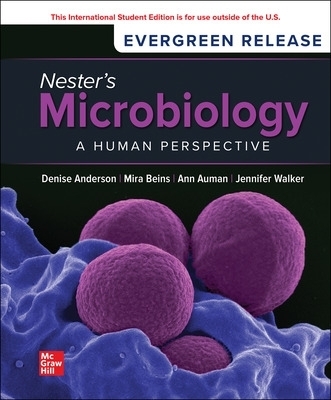
Nester's Microbiology: A Human Perspective: 2024 Release ISE
McGraw-Hill Education (Verlag)
978-1-266-86755-2 (ISBN)
Denise Anderson is a Senior Lecturer in the Department of Microbiology at the University of Washington, where she teaches a variety of courses including general microbiology, medical bacteriology laboratory, and medical mycology/parasitology laboratory. Equipped with a diverse educational background, including undergraduate work in nutrition and graduate work in food science and in microbiology, she first discovered a passion for teaching when she taught microbiology laboratory courses as part of her graduate training. Her enthusiastic teaching style, fueled by regular doses of Seattle’s famous coffee, receives high reviews by her students. Outside of academic life, Denise relaxes in the Phinney Ridge neighborhood of Seattle, where she lives with her husband, Richard Moore, and dog, Dudley (neither of whom are well trained). When not planning lectures, grading papers, or writing textbook chapters, she can usually be found chatting with the neighbors, fighting the weeds in her garden, or enjoying a fermented beverage at the local pub. Sarah Salm is a Professor at the Borough of Manhattan Community College (BMCC) of the City University of New York, where she teaches microbiology, anatomy and physiology, and general biology. She earned her undergraduate and doctoral degrees at the University of the Witwatersrand in Johannesburg, South Africa. She later moved to New York, working first as a postdoctoral fellow and then an Assistant Research Professor at NYU Langone Medical Center. Her research has covered a range of subjects, from plant virus identification through prostate stem cell characterization. When not focused on the textbook and her classes, Sarah loves to read, hike, and travel. Although no longer an active member of the author team, Eugene (Gene) Nester wrote the original version of the present text with Evans Roberts and Nancy Pearsall more than 30 years ago. That text, Microbiology: Molecules, Microbes and Man, pioneered the organ system approach to the study of infectious disease, and was developed specifically for allied health sciences. Gene did his undergraduate work at Cornell and received his Ph.D. in microbiology from Case Western University. He then did postdoctoral work in the Department of Genetics at Stanford University with Joshua Lederberg. Following that, he joined the faculty in the Department of Microbiology at the University of Washington, where he remains active as an emeritus member. His laboratory demonstrated that Agrobacterium transfers DNA into plant cells—the basis for the disease crown gall—a system of gene transfer that has become a cornerstone of plant biotechnology. In recognition of his work, he was awarded the Australia Prize and the Cetus Prize in Biotechnology, and was elected to fellowship in the National Academy of Sciences, the American Academy for the Advancement of Science, the American Academy of Microbiology, and the National Academy of Sciences in India.
1: Humans and the Microbial World
2: The Molecules of Life
3: Cells and Methods to Observe Them
4: Dynamics of Microbial Growth
5: Control of Microbial Growth
6: Microbial Metabolism: Fueling Cell Growth
7: The Blueprint of Life, from DNA to Protein
8: Bacterial Genetics
9: Biotechnology
10: Identifying and Classifying Microorganisms
11: The Diversity of Bacteria and Archaea
12: The Eukaryotic Members of the Microbial World
13: Viruses, Viroids and Prions
14: The Innate Immune Response
15: The Adaptive Immune Response
16: Host-Microbe Interactions
17: Applications of Immune Responses
18: Immunological Disorders
19: Epidemiology
20: Antimicrobial Medications
21: Respiratory System Infections
22: Skin Infections
23: Wound Infections
24: Digestive System Infections
25: Blood and Lymphatic Infections
26: Nervous System Infections
27: Genitourinary Tract Infections
28: Microbial Ecology
29: Environmental Microbiology: Treatment of Water, Wastes, and Polluted Habitats
30: Food Microbiology
| Erscheinungsdatum | 22.03.2024 |
|---|---|
| Zusatzinfo | 646 Illustrations |
| Verlagsort | OH |
| Sprache | englisch |
| Gewicht | 1669 g |
| Themenwelt | Naturwissenschaften ► Biologie ► Mikrobiologie / Immunologie |
| ISBN-10 | 1-266-86755-4 / 1266867554 |
| ISBN-13 | 978-1-266-86755-2 / 9781266867552 |
| Zustand | Neuware |
| Haben Sie eine Frage zum Produkt? |
aus dem Bereich


